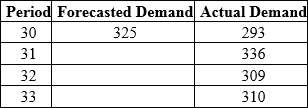APICS CPIM-BSP CPIM – Basics of Supply Chain Management Total Online Training
APICS CPIM-BSP Online Training
The questions for CPIM-BSP were last updated at Jul 18,2025.
- Exam Code: CPIM-BSP
- Exam Name: CPIM - Basics of Supply Chain Management Total
- Certification Provider: APICS
- Latest update: Jul 18,2025
Which of the following items is a source of independent demand?
- A . Customer orders for finished products
- B . Subassembly requirements from material requirements planning
- C . Raw material requirements from material requirements planning
- D . Protective packaging for shipping customer orders
Which of the following calculations is a major component that is used with extrinsic forecasting?
- A . Moving average
- B . Exponential smoothing
- C . A seasonal index
- D . An economic indicator
The question below is based on the following information:

What is the mean absolute deviation of demand for the data?
- A . 1
- B . 3
- C . 5
- D . 101
Which of the following forecasting techniques reviews a company’s sales history?
- A . Qualitative
- B . Delphi
- C . Extrinsic
- D . Intrinsic
Which of the following forecasting techniques eliminates the need to keep months of historical data?
- A . Exponential smoothing
- B . Seasonal index
- C . Delphi
- D . Trend
A 5-year decline in demand for diapers most closely represents which of the following types of forecast patterns?
- A . Irregular
- B . Cyclic
- C . Trend
- D . Seasonal
Which of the following smoothing constants places the most weight on the old forecast?
- A . 0.4
- B . 0.3
- C . 0.2
- D . 0.1
Which demand management activity includes processing a customer request and making material available for production or shipping?
- A . Forecasting
- B . Order processing
- C . Providing available-to-promise dates
- D . Communicating with the marketplace
Which of the following forecast inputs is considered to be intrinsic data?
- A . Demographic
- B . Econometric
- C . Historical sales
- D . Market survey
A primary purpose of Quality Function Deployment is to:
- A . calculate performance limits.
- B . determine marketing strategies.
- C . direct product design.
- D . set pass/fail criteria.
Latest CPIM-BSP Dumps Valid Version with 155 Q&As
Latest And Valid Q&A | Instant Download | Once Fail, Full Refund

